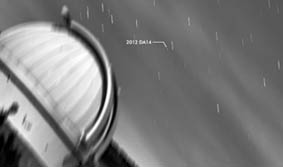
The Astronomical Observatory of the University of Valencia recorded on 15 February 2012 DA14 the passage of the asteroid from its station in Aras de los Olmos. The video, available on YouTube, covers the route of the asteroid in the sky during a thirty-two minutes, combining the astronomical image with the view of the horizon next to our telescopes.
A few days ago, the asteroid 2012 DA14 passed barely touching Earth only 27,000 miles high above the surface. It is a rocky object whose orbit is similar to that of the Earth and it visits us about every year.With radar observations it has been shown that it has an elongated shape, measuring about forty meters long.
The video presented here includes images of the asteroid 2012DA14 on 15 February.The images, taken from the station of the Astronomical Observatory of the University of Valencia in Aras de los Olmos, cover the distance of the asteroid in the sky for a period of thirty-two minutes since shortly after sunset, when the asteroid show its head just above the horizon.
The technique used to potograph the asteroid is similar to that used when photographing objects that move at high speeds. Let's imagine that we want to photograph a car in a Formula 1 race; in order for the car to not appear blurry we would have to follow its movement with our camera. This will make the object appear defined and clear in our photo, except for the remaining objects, which will move in the camera's direction.
The same happens with video, taken on lens mounted on top of the Observatory's telescopes. Each one of the frames, which correspond to thirty seconds of exposition, the telescope follows the asteroid movement so that the image is clear. As the asteroid is moving at high speeds, the remaining starts surrounding it leave a straight trace in each one of the images.
The video is peculiar and different from other videos that we have seen during the last days, as it combines the astronomic image with the horizon views close to our telescopes -which also appear moving towards the camera's moving direction-. This way, the video does not only capture the passing of the asteroid through the sky, but also its passing through the Aras Observatory, located at Mola de Santa Catalina, under the dark skies of inland Valencian Country.
The video is also available at YouTube
Video credits: Vicent Peris (OAUV), Óscar Breviá (OAUV), Javier Díez, OAUV.
Last update: 22 de february de 2013 07:59.
News release



















